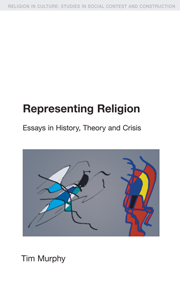Book contents
- Frontmatter
- Dedication
- Contents
- Acknowledgements
- Chapter 1 The “Crisis of Representation” and the Academic Study of Religion
- Part I Phenomenology, Consciousness, Essence: Critical Surveys of the History of the Study of Religion
- Part II Towards a Nietzschean Semiotics of Religion
- Chapter 6 (Post)Structural (Dis)Placements: Genealogy, Religious Studies, and the Problematics of Historical Identity
- Chapter 7 “Religion” as the Structuring of Asymmetrical Relations: Towards a Definition
- Chapter 8 Towards a Semiotic Theory of Religion
- Notes
- Bibliography
- Index of Subjects
- Index of Names
Chapter 7 - “Religion” as the Structuring of Asymmetrical Relations: Towards a Definition
from Part II - Towards a Nietzschean Semiotics of Religion
- Frontmatter
- Dedication
- Contents
- Acknowledgements
- Chapter 1 The “Crisis of Representation” and the Academic Study of Religion
- Part I Phenomenology, Consciousness, Essence: Critical Surveys of the History of the Study of Religion
- Part II Towards a Nietzschean Semiotics of Religion
- Chapter 6 (Post)Structural (Dis)Placements: Genealogy, Religious Studies, and the Problematics of Historical Identity
- Chapter 7 “Religion” as the Structuring of Asymmetrical Relations: Towards a Definition
- Chapter 8 Towards a Semiotic Theory of Religion
- Notes
- Bibliography
- Index of Subjects
- Index of Names
Summary
In his famous definition of religion, Emil Durkheim articulated the classic functional premise, a virtual article of faith in the social-scientific study of religion, that the predominant effect of religious beliefs and practices was “to unite into one single moral community all those who adhere to them” (Durkheim 1995, 44, emphasis added). However, even a casual survey of the history of religions shows that this is, at best, a half truth. Insofar as religions unite one group, they do so by differentiating its members and its membership from other groups. Difference, not unity, is the dominant trope of the history of religions. Identity, the formation of “one single moral community,” the creation of a sense of “we,” is formed by a complex and simultaneous sic et non, yes and no, a movement both of inclusion and exclusion, a gesture which creates both an inside and an outside, which, simultaneously, necessarily creates both a “we” and a “not-we,” an “us” over and against a “them.” The correlative terms of this oppositional, differential structure are never weighted equally, quite the contrary: at the very core, the very “essence” of religion, lay asymmetrical valuations. All religions, in a bewildering variety of ways, are predicated upon a process of asymmetrical structuration. The “we” and the “not-we” mutually define each other but never as equal terms, never outside a sometimes more and sometimes less but always violent, a sometimes open and sometimes hidden but ever present, hierarchy of valuation.
Examples of this identity formation via differentiation in the history of religions abound. For instance, the civilization of ancient Persia and that of the Indo-Aryans (who would later become “Hindus”) grew up side by side. Both groups grew into “high cultures” with vast religious literatures and sprawling urban empires.
- Type
- Chapter
- Information
- Representing ReligionEssays in History, Theory and Crisis, pp. 137 - 155Publisher: Acumen PublishingPrint publication year: 2007



